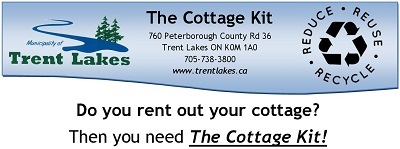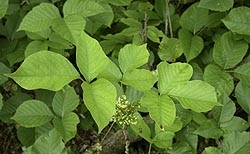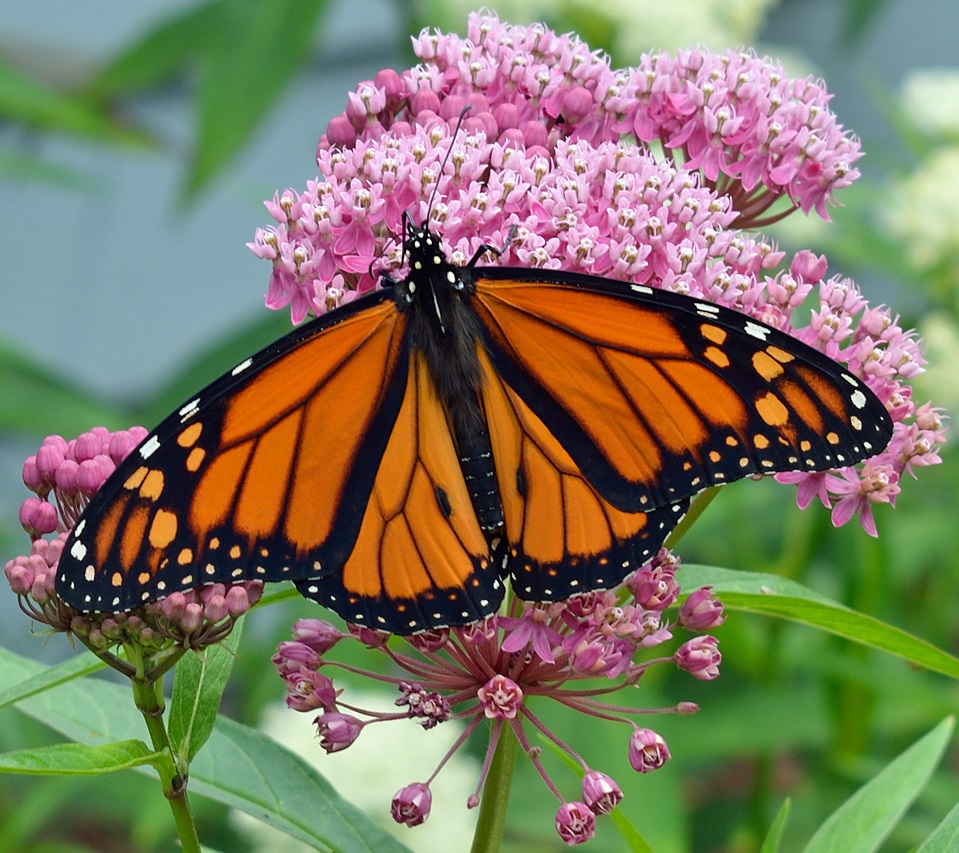Backyard Composting
What can go in a backyard composter.
- Coffee grounds and filters
- Tea bags and leaves
- Eggshells
- Fruits and vegetables
- Grass clippings
- Leaves
- Plant trimmings
- Weeds (not in seed)
- Sawdust (untreated wood)
- Wood ash (cold, untreated wood)
Don't put these in your backyard composter
- BBQ ash/charcoal
- Dairy products
- Meat, fish or bones
- Oils
- Pet waste
- Plants treated with pesticides
- Treated wood ash or sawdust
- Vacuum cleaner lint
- Weeds in seed
September 24\18
Garbage Dumping
If you find garbage on the road, please take a photo and email the photo to the Trent Lakes Municipal office or give them a call. They will send someone to pick up the garbage or you may take the unsorted garbage to the transfer station with prior approval.
Here is the contact page on the Trent Lakes website. April 12\18
Cottage Kits
If you lend or rent your cottage, please ensure that occupants understand how to properly dispose of garbage. If you don't make arrangements for them, don't assume they'll take the garbage home.
You can purchase a Cottage Kit at the transfer station. It includes a single pass and disposal bags. Click on the image below for more information.

April 12\18
Nature - Our Best Defense Against Flooding
THINK twice before you harden your shoreline or change a wetland. You could affect our ability to combat flooding.
Read the full article on the David Suzuki
website.
Excerpts from the article:
Floods have become one of the most visible signs of the effects of climate change in cities, towns and rural areas throughout Canada.
Spring floods aren't unusual, but the intensity and frequency of recent rains are breaking records.
Deforestation, wetland destruction and artificial shoreline projects worsen the problem.
July 19\17
Poison Ivy
Identify it. Avoid it.

Poison Ivy may be difficult to identify. It spreads by runners. It can be very small or tall and bushy depending on how established it has become. Leaves are reddish to green when starting to show in May, but will turn solid green. The leaves turn red when it dies off in the fall. Leaves can be shiny or dull, droopy or upright. There are always three leaves, two opposite each other with a third lower leaf.
It is a native plant. If it is on your property and it is difficult to avoid, you can spray it with a weedkiller, but it will grow back. The pesticide ban in Ontario does allow you to spray poison ivy, but is not allowed for cosmetic use, i.e., grass or dandelions in your driveway.
If you are able pull out poison ivy, dispose of it in the garbage. Do not burn or compost. If you are allergic, you can react to debris in an area where poison ivy once was.
May 21\17
Invasive Plant Species

Check before you plant
For a plant to be classified as invasive it must be a non-native with a tendency to spread, threaten the environment, social or economic health of the area. The problem is simple to understand; as there are no natural diseases or pests to control them, like native plants, they can spread uncontrollably and crowd out our native plants. There are over 400 species of invasive plants in Ontario.
Last year's brilliant and well meaning campaign by Cheerios to 'bring back the bees' resulted in 400 million seeds being sent out across Canada and 1.5 billion were sent out in total across North American included forget-me-nots. Forget-me-nots are native to Africa and were introduced to gardens because of their beauty, and because they have no natural checks and balances they can quickly escape their boundaries.
Many invasive plants are beautiful and some have even been sold innocently by garden centres, such as periwinkle and ornamental grasses. An ornamental grass can be controlled in a city but when people bring them to the cottage and let them grow uncontrollably we create a situation that can disrupt our healthy biodiversity. Phragmites is an invasive perennial grass that originated in Eurasia and is quickly becoming Ontario's worst invasive plant. Phragmites release toxins from their roots that obstruct the growth of other native plants as they outcompete them for sunlight, water and nutrients. They will kill off the natural bulrushes and cattails. With their dense clusters there is no wildlife that will live within it; no nests or wildlife activity, just quiet.
To learn more about Phragmites and how to identify it go to:
Invasive Phragmites - Best Management Practices.
If you think you have seen an invasive species please report it to:
Invading Species Hotline at 1-800-563-7711 or by email: info@invadingspecies.com
You can check out what to grow instead here: Grow Me Instead.
October 16\17
Fireworks By-law
The Municipality of Trent Lakes approved a Fireworks By-law which came into effect on October 15, 2019.
Fireworks are now restricted to specific days and times.
Note: no fireworks are allowed in the spring due to the effect on nesting birds, particularly loons.
Flying lanterns are prohibited in Trent Lakes as are any type of fireworks during a Burn Ban.
Permitted dates and times:
New Year's Eve - between 8:00 p.m. and 1:00 a.m. the following day.
Canada Day - between 8:00 p.m. and 11:00 p.m. on July 1st and the weekends directly preceding and following it.
Civic Holiday - between 8:00 p.m. and 11:00 p.m. on the statutory holiday (Monday) and the weekend directly preceding it.
Labour Day - between 8:00 p.m. and 11:00 p.m. on the statutory holiday (Monday) and the weekend directly preceding it. October 25\19
|
Starry Stonewort Committee Update, March 28, 2022
From Dawn Griffin, SSW Committee Chair
As you may know, starry stonewort (SSW)--which is quite a pretty name for such an aggressive and ecologically devastating aquatic invasive plant species--is, unfortunately, now making itself comfortable in Big Bald Lake and the Trent-Severn Waterway. If you don't know much about it, visit Invading Species.com/invaders/aquatic-plants/starry-stonewort/ to get a good overview, but the short story is that SSW is an invasive plant that:
- creates thick matted "deserts" where native aquatic plant species, fish, insects, etc. cannot survive
- establishes new colonies from just a tiny fragment of the plant so it spreads very easily (e.g. by swimming or boating through infested areas)
- is difficult to impossible to eradicate; and
- is spreading quickly through Ontario waterways.
On January 26th, 2022, BBLCA's newly formed SSW Committee had the opportunity to attend the Ontario Starry Stonewort (SSW) Partners meeting, hosted by Nature Conservancy Canada. The meeting brought together local organizations, homeowners, cottager's associations, botanists, ecologists, and water quality specialists to share information, collaborate on methods to help control the spread of SSW and to try to combat it where we can. You can read the meeting minutes, but we've learned that:
- Diver Assisted Suction Harvesting (DASH) has proven to be somewhat effective control method in the New York Finger Lakes, though monitoring continues
- herbicides/algicides are not effective and are more likely to impact native species than SSW growth/spread
- plant suppressing (benthic) mats are only effective if they are moved frequently or SSW will colonize in the sediment on top
- SSW has a lot of lookalikes and can look very different in different water conditions so identification of new colonies can be tricky (check out this SSW Identification Guide)
For Big Bald Lake, our committee continues to look for companies that can provide DASH services in Ontario to get more information. We are also looking into how we can raise awareness about SSW and its impacts on Big Bald Lake, as well as how we can partner with organizations to share signage, information, and control and management methods. Stay tuned.
To learn more about SSW, check out these links:
Starry Stonewort
For information on Starry Stonewort, see the Ontario Invasive Species website.
We have a Starry Stonewort Committee!
Dawn Griffin (Chair)
Lucianna Adragna
Sue Flanagan
Nancy Boyce
Our association will be working with a newly formed network of people interested in Starry Stonewort in Southern Ontario. The group is comprised of researchers, representatives from invasive species organization, the Nature Conservancy of Canada, Parks Canada, environmental groups, and representatives from lakes infested with Starry Stonewort. They are currently planning a January meeting and Dawn will attend to represent our lake. This will give us a chance to share the Big Bald Lake experience and hear what other lakes are doing. They are also hoping for updates from the Invading Plant Council, the Ontario Invading Species Awareness Program, TSW, and their researchers.
We recently received a report from this working group which you may read
here.
November 27\21
The Starry Stonewort Committee attended a virtual meeting on December 8th hosted by Finger Lakes PRISM (Partnership for Regional Invasive Species Management). Of particular interest to us was a presentation about removing Starry Stonewort using DASH (Diver Assisted Suction Harvesting). This method of SS removal is more successful than mechanical harvesting because it does not leave fragments behind that will regrow. We are currently researching whether this method is available in Ontario and feasible for our lake. We continue to do SS research and partner with organizations.
December 8\21

Starry Stonewort is taking over Catalina Bay and is in other parts of the lake including May Bay.
Starry Stonewort is a bushy, bright green macro-algae. It produces a characteristic star-shaped bulbil. The unwanted algae grow into thick bushes that can take over breeding areas for fish, overcome native vegetation, and disrupt a lake's recreational activities such as boating and swimming.
See below for a map showing the location of Starry Stonewort in our lake. Notify us if you know of a location that doesn't show on the map.
Let us know if you would like to join a Starry Stonewort working group.
Some of the things that a working group could do is to work with other agencies to report Starry Stonewort sightings. For example, MNRF looks at EDDMapS when setting invasive species priorities. Another idea would be to create and post signs on the lake to advise boaters of the location of the weeds.
Click on the map below to see a larger image.

September 30\21
Demonstration Site Plants
This is a list of the native plants that were used for our demonstration site:
- Sweet gale
- Boneset
- White Turtlehead
- Potentilla yellow
- Potentilla white
- Woodland sunflower
- Smooth Rose (aka wild rose)
- Beebalm (aka red bergamot)
- Joe pyeweed
- Blue lobelia
July 12\17
Our top perennial picks for your shoreline are: Swamp Milkweed, Blue Flag Iris, Blue Lobelia and Joe Pye Weed. Great shrubs are Red Osier Dogwood, Willow and Sweetgale.
Why native plants? Native plants provide food for birds, bees and other pollinators. May 31\17
Biodiversity

Biodiversity is the variety of life. We cannot survive independently of each other. We need to have diverse plants and animals.
In an effort to increase biodiversity and improve our water quality, we are educating our lake residents about the importance of natural shorelines. We'll be planting a demonstration site on the lake. Also, we are distributing native plant starter kits.
By planting a variety of native plants along your shore, you'll:
- attract pollinators
- support the food web
- provide a buffer against species loss
- deter geese from your property
- prevent toxins from entering into the lake
- reduce pests
- eliminate the need for fertilizers
- reduce erosion
April 5\17
|
2024 E.coli Test Results
Click on the image below to see a larger image.

See the Kawartha Lake Stewards Annual Reports for past E.coli and Phosphorus and Secchi Depth testing results.
Remember: do not swim after a heavy rain as that is when E.coli levels are highest.
E.coli Testing Sites
Click on the map below to see the sites that are being tested.

How we can reduce E.coli
The following is an excerpt from an article in the KLSA Lake Water Quality 2015 Report, Protecting the Natural Beauty Around Us.
We can help keep our lakes cleaner by:
- discouraging large populations of waterfowl
by keeping our shorelines well vegetated. (Clear
sightlines from the water to lush green grass are
very inviting to geese!)
- reducing erosion, e.g., interrupt the flow of water
off the land with plants and curving paths
- minimizing lake sediment disturbance, e.g., keep
your boat's power down until you are in deeper
water.
... and from our Water Quality Testing Report
Tips on Protecting our Lake and Yourself
- Don't feed geese and other waterfowl.
- Naturalize shorelines.
- Don't swim after a heavy rain.
- Clean up and properly dispose of any animal waste from geese and dogs.
- Don't overload your septic - spread out your laundry loads.
- Have your septic tank pumped out every three years.
June 5\16
Blue-green Algae

Excerpts from:
2016 FOCA Lake Stewards Newsletter and
Peterborough Public Health - Blue-green Algae
What are blue-green algae?
Blue-green algae are not really algae, and they aren't even always blue-green. They are actually a type of bacteria called "Cyanobacteria" that get their energy through photosynthesis, like plants do. Cyanobacteria are known for rapidly reproducing and collecting to form large, highly visible blooms that can appear throughout the water, on the surface of water as a scum, or on the lake bottom as a mat. Some species of cyanobacteria can release toxins into the water when the cells that make up the bloom rupture or die. Some species do not; blooms contain a mix of species, but it is estimated that up to half of cyanobacterial blooms are non-toxic.
Factors affecting blooms
Within lakes, cyanobacteria can occur naturally in low numbers,
but under certain conditions their numbers can
increase dramatically, leading to blooms. A wide variety
of factors are linked to the formation of blooms, but the
most significant ones are increased nutrient input to
lakes, and a number of specific meteorological conditions
such as high water temperature, low rainfall/precipitation
and reduced wind speeds.
Consequently, blooms typically develop in shallow,
sheltered bays and during the summer or fall when these
meteorological conditions are most likely to occur.
How you can help
Management of nutrient inputs into lakes remains
a crucial step in controlling the occurrence and
frequency of algal blooms. Your personal actions
in support of this effort could range from using
phosphate-free products, to naturalizing your
shoreline which helps reduce erosion and phosphorus
loading. Reducing phosphorus loading will serve
to reduce one of the major predisposing conditions
necessary for bloom occurrence.
What should I do if I think I have spotted a blue-green algae bloom?
If you see an algae bloom that you think may be blue-green algae, report it to the MInistry of the Environment (MOE) by calling 1-800-268-6060. If it is the first blue-green algae bloom of the season on that lake or in that area, the Ministry will take a sample of the algae and identify whether it contains cyanobacteria. They will also test the toxin level from a dense area of the bloom, but will not return to confirm that the bloom or the toxin levels have dissipated. Subsequent blooms will not be individually identified.
September 5\16
|









